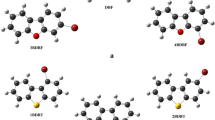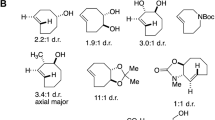Abstract
Density functional theory calculations at the M06-2X level were done to study the reaction mechanism and regioselectivity for the [2+2] cycloaddition of allyltrimethylsilane with alkynones using InBr3 as the catalyst. The solvent effect was described by the single-point calculations with SMD model in 1,2-dichloroethane. The calculation results prove that the InBr3-catalyzed cycloaddition of allyltrimethylsilane to alkynones takes place through two possible pathways and get selective cyclobutenone products. The reaction involves two main steps: attack of unsaturated carbon atoms of the alkynone by the π electrons of allyltrimethylsilane and a closed-loop process. The process of forming cyclobutenone product of silicon in the 2-position of the ketone group is more favored and the barrier is 15.5 kcal/mol, while the energies for the cyclobutenone of 3-position product are relatively high of 21.2 kcal/mol. In addition, we calculated the catalytic activity of the InX3(X = Cl, Br, I) catalyst for this cycloaddition. This is a good explanation for the experimental data that InBr3 and InI3 would be the most effective catalysts.

M06-2X calculation was done to study the reaction mechanism for the [2+2] cycloaddition of allyltrimethylsilane with alkynones by InBr3 catalyst. The reaction involves attack of the unsaturated carbon atoms of the alkynone by π electrons and a closed-loop process. The cyclobutenone product of silicon in the 2-position of the ketone group is more favored.






Similar content being viewed by others
References
Anslyn E V and Dougherty D A 2006 In Strain and stability. Modern physical organic chemistry (Sausalito, CA: University Science Books) p. 65
Namyslo J C and Kaufmann D E 2003 The application of cyclobutane derivatives in organic synthesis Chem. Rev. 103 1485
Snider B B 1976 The stereospecific aluminum chloride catalyzed [2+2] cycloaddition of propiolate esters with unactivated alkenes J. Org. Chem. 41 3061
Snider B B, Brown L A, Conn R S E and Killinger T A 1977 The lewis acid catalyzed reaction of 3-butyn-2-one with alkenes Tetrahedron Lett. 18 2831
Fienemann H and Hoffmann H M R 1979 Cyclobutenecarboxylic esters via aluminum chloride induced [2+2] cycloadditions of 2-propynoic esters to cyclic olefins J. Org. Chem. 44 2802
Snider B B, Rodini D J, Conn R S E and Sealfon S 1979 Lewis acid catalyzed reactions of methyl propiolate with unactivated alkenes J. Am. Chem. Soc. 101 5283
Clark R D and Untch K G 1979 [2+2] Cycloaddition of ethyl propiolate and silyl enol ethers J. Org. Chem. 44 248
Rosenblum M and Scheck D 1982 Condensation of propiolic esters with olefins catalyzed by the C5 H 5Fe(CO)2 cation Organometallics 1 397
Faron K L and Wulff W D 1988 The chromium and tungsten pentacarbonyl groups as reactivity auxiliaries in [2+2] cycloadditions J. Am. Chem. Soc. 110 8727
Ishihara K and Fushimi M 2008 Catalytic enantioselective [2 + 4] and [2+2] cycloaddition reactions with propiolamides J. Am. Chem. Soc. 130 7532
Lautens M, Klute W and Tam W 1996 Transition mmetal-mediated cycloaddition reactions Chem. Rev. 96 49
Lopez-Carrillo V and Echavarren A M 2010 Gold(I)-catalyzed intermolecular [2+2] cycloaddition of alkynes with alkenes J. Am. Chem. Soc. 132 9292
Hilt G, Paul A and Treutwein J 2010 Cobalt catalysis at the crossroads: Cobalt-catalyzed alder-ene reaction versus [2+2] cycloaddition Org. Lett. 12 1536
Nishimura A, Ohashi M and Ogoshi S 2012 Nickel-catalyzed intermolecular [2+2] cycloaddition of conjugated enynes with alkenes J. Am. Chem. Soc. 134 15692
Sakai K, Kochi T and Kakiuchi F 2013 Rhodium-catalyzed intermolecular [2+2] cycloaddition of terminal alkynes with electron-deficient alkenes Org. Lett. 15 1024
Pappas S P, Pappas B C and Portnoy N A 1969 Synthesis and solvolytic rearrangement of 1-methoxybicyclo[4.2.0]octa-3,7-diene-2,5-diones J. Org. Chem. 34 520
Serve P and Rosenberg H M 1970 New route to the 2-oxabicyclo[3.2.0]hept-6-ene ring system J. Org. Chem. 35 1237
Bloomfield J J and Owsley D C 1971 Photochemistry of acetylenes. I. Photoaddition of ethylene to dimethyl acetylenedicarboxylate J. Am. Chem. Soc. 93 782
Koft E R and Smith A B 1984 Intramolecular [2+2] photocyclizations. 2. Total synthesis of (. + -.)-hibiscone C (gmelofuran) J. Am. Chem. Soc. 106 2115
Hosomi A 1988 Characteristics in the reactions of allylsilanes and their applications to versatile synthetic equivalents Acc. Chem. Res. 21 200
Miura K and Hosomi A 2006 Allylsilanes, Allenylsilanes, and Propargylsilanes. In Main Group Metals in Organic Synthesis H Yamamoto and K Oshima (Eds.) (Weinheim: Wiley-VCH) p. 489
Hojo M, Tomita K, Hirohara Y and Hosomi A 1993 New access to Di-exo-methylenecyclobutanes via [2+2] cycloaddition of 3-methylthio-4-trimethylsilyl-1, 2-butadiene with alkenes mediated by a Lewis acid Tetrahedron Lett. 34 8123
Monti H, Audran G, Leandri G and Monti J P 1994 ZnI2 Catalyzed [2+2] versus [3 + 2] cycloaddition of an allyltrimethylsilane with 3-butyn-2-one: Confirmation of a cyclobutene by-product formation Tetrahedron Lett. 35 3073
Inanaga K, Takasu K and Ihara M 2005 A practical catalytic method for preparing highly substituted cyclobutanes and cyclobutenes J. Am. Chem. Soc. 127 3668
Takasu K, Hosokawa N, Inanaga K and Ihara M 2006 Cyclobutane ring formation by triflic imide catalyzed [2+2]-cycloaddition of allylsilanes Tetrahedron Lett. 47 6053
Okamoto K, Tamura E and Ohe K 2014 Stereoselective construction of 1,3-disilylcyclopentane derivatives by scandium-catalyzed [3 + 2] cycloaddition of allylsilanes to β-silylenones Angew. Chem. Int. Ed. 53 10195
Okamoto K, Tamura E and Ohe K 2013 Acid-catalyzed direct conjugate alkenylation of α, β-unsaturated ketones Angew. Chem. Int. Ed. 52 10639
Okamoto K, Shimbayashi T, Tamura E and Ohe K 2015 Indium-catalyzed [2+2] cycloaddition of allylsilanes to internal alkynones Org. Lett. 17 5843
Behzadi M, Saidie K, Islami M R and Khabazzadeh H 2016 Experimental and theoretical investigation of benzyl-N-pyrrolylketene, one-step procedure for preparing of new β-lactams by [2+2] cycloaddition reaction J. Chem. Sci. 128 111
Benallou A, Abdallaoui H A and Garmes H 2016 A conceptual DFT approach towards analysing feasibility of the intramolecular cycloaddition Diels-Alder reaction of triene amide in Lewis acid catalyst J. Chem. Sci. 128 1489
Marakchi K, Ghailane R, Kabbaj O K and Komiha N 2014 DFT study of the mechanism and stereoselectivity of the 1,3-dipolar cycloaddition between pyrroline-1-oxide and methyl crotonate J. Chem. Sci. 126 283
Wang N N, Tan X J, Wang W H and Li P 2016 Theoretical insights into the cycloaddition reaction mechanism between ketenimine and methyleneimine: An alternative approach to the formation of pyrazole and imidazole J. Chem. Sci. 128 279
Tia R, Adei E, Baidoo J and Edor J 2016 Quantum chemical study of the mechanisms of oxidation of ethylene by Molybdyl and Tungstyl Chloride J. Chem. Sci. 128 707
Zhao Y and Truhlar D G 2008 The M06 suite of density functionals for main group thermochemistry, thermochemical kinetics, noncovalent interactions, excited states, and transition elements: Two new functionals and systematic testing of four M06-class functionals and 12 other functionals Theor. Chem. Acc. 120 215
Parr R G and Yang W 1989 In Density-functional Theory of Atoms and Molecules (New York: Oxford University Press)
Ajitha M J and Huang K W 2016 Mechanism and regioselectivity of Rh(III)-Catalyzed intermolecular annulation of aryl-substituted diazenecarboxylates and alkenes: DFT insights Organometallics 35 450
Wei X X, Fang R and Yang L Z 2015 Mechanism of N-heterocylic carbene-catalyzed annulation of allenals with chalcones to 3-pyrancarbaldehydes or cyclopentene Catal. Sci. Technol. 5 3352
Zhao Y and Truhlar D 2008 Density functionals with broad applicability in chemistry Acc. Chem. Res. 41 157
Zhao Y and Truhlar D G 2008 Exploring the limit of accuracy of the global hybrid meta density functional for main-group thermochemistry, kinetics, and noncovalent interactions J. Chem. Theory. Comput. 4 1849
Jacquemin D, Perpète E A, Ciofini I, Adamo C, Valero R, Zhao Y, Truhlar D and 2010 On the performances of the M06 family of density functionals for electronic excitation energies Vol. 6, p. 2071
Dolg M, Wedig U, Stoll H and Preuss H 1987 Energy-adjusted ab initio pseudopotentials for the first row transition elements J. Chem. Phys. 86 866
Dolg M, Stoll H, Savin A and Preuss H 1989 Energy-adjusted pseudopotentials for the rare earth elements Theor. Chim. Acta 75 173
Schwerdtfeger P, Dolg M, Schwarz W H E, Bowmaker G A and Boyd P D W 1989 Laser-induced fluorescence spectroscopy of NCS in a free jet expansion J. Chem. Phys. 91 762
Andrae D, Haeussermann U, Dolg M, Stoll H and Preuss H 1990 Energy-adjusted ab initio pseudopotentials for the second and third row transition elements Theor. Chim. Acta 77 123
Dolg M, Stoll H and Preuss H 1993 A combination of quasirelativistic pseudopotential and ligand field calculations for lanthanoid compounds Theor. Chim. Acta 85 441
Hollwarth A, Bohme M, Dapprich S, Ehlers A W, Gobbi A, Jonas V, Kohler K F, Stegmann R, Veldkamp A and Frenking G 1993 A set of d-polarization functions for pseudo-potential basis sets of the main group elements Al Bi and f-type polarization functions for Zn, Cd, Hg Chem. Phys. Lett. 208 237
Ehlers A W, Bohme M, Dapprich S, Gobbi A, Hollwarth A, Jonas V, Kohler K F, Stegmenn R and Frenking G 1993 A set of f-polarization functions for pseudo-potential basis sets of the transition metals Sc Cu, Y Ag and La Au Chem. Phys. Lett. 208 111
Rassolov V A, Ratner M A, Pople J A, Redfern P C and Curtiss L A 2001 6-31G* basis set for third-row atoms J. Comput. Chem. 22 976
Fukui K 1970 Formulation of the reaction coordinate J. Phys. Chem. 74 4161
Fukui K 1981 The path of chemical reactions - the IRC approach Acc. Chem. Res. 14 363
Marenich A V, Cramer C J and Truhlar D G 2009 Universal solvation model based on solute electron density and on a continuum model of the solvent defined by the bulk dielectric constant and atomic surface tensions J. Phys. Chem. B 113 6378
Frisch M J et al., 2009 Gaussian 09, revision A.01; Gaussian, Inc.: Pittsburgh, PA.
Chatt J and Duncanson J A 1953 Olefin co-ordination compounds. Part III. Infra-red spectra and structure: Attempted preparation of acetylene complexes J. Chem. Soc. 3 2939
Acknowledgements
This work was supported by Longyuan young creative talents to support projects, Gansu Province (2014-98), and the Natural Science Foundation of Department of Education, Gansu Province (2016B-121). We are grateful to the Gansu Province Supercomputer Center for essential support. We are grateful to the Reviewers for their invaluable suggestions.
Author information
Authors and Affiliations
Corresponding author
Additional information
Supporting Information (SI)
Tables giving Cartesian coordinates for the calculated stationary structures obtained from the DFT calculations are given in Supplementary Information, which is available at www.ias.ac.in/chemsci.
Electronic supplementary material
Below is the link to the electronic supplementary material.
Rights and permissions
About this article
Cite this article
ZHANG, X.H. DFT study on the mechanism of InBr3-catalyzed [2+2] cycloaddition of allyltrimethylsilane with alkynones. J Chem Sci 129, 505–513 (2017). https://doi.org/10.1007/s12039-017-1260-z
Received:
Revised:
Accepted:
Published:
Issue Date:
DOI: https://doi.org/10.1007/s12039-017-1260-z




